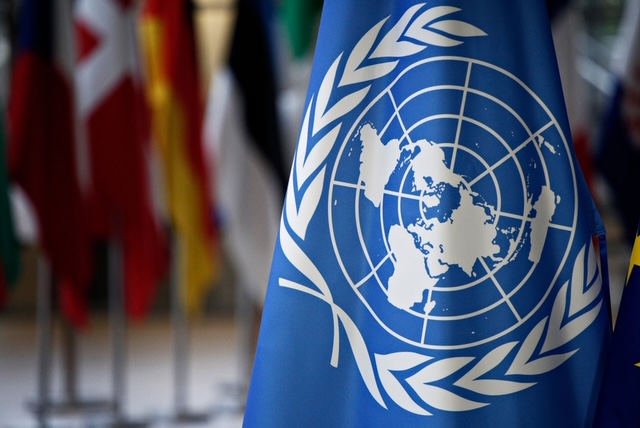
Plastic Pollution
The VI Supports a Global Plastics Agreement that Creates a Circular Economy for All Plastics and Eliminates Plastic Pollution
The Vinyl Institute (VI) recognizes the need for a global plastics agreement that creates a circular economy for all plastics and eliminates plastic pollution. The Vinyl Institute is participating in the United Nation’s Intergovernmental Negotiating Committee (UN INC) on Plastic Pollution meetings.
The VI advocates for the following positions:
We support an ambitious plan to eliminate plastic pollution through an implementable agreement.
The Instrument should include attainable and science-backed measures to increase circularity while remaining flexible enough to allow for different solutions to address impacts at the various stages of the lifecycle, taking into account national circumstances. Prescriptive measures will not accommodate the diversity of consumer and social behaviors, production practices, waste management capacity, and environmental factors across the spectrum of countries that would be bound by this Instrument. Flexibility is essential for innovation and solution-finding. To support and enhance robust science- and evidence-based approaches to the issue of plastic pollution, VI, along with our industry, strongly encourages consulting with the industry when determining solutions to strengthen the scientific rigor and weight of evidence of any proposal.
We support policies that accelerate the implementation of UN SDGs and include plastic products.
We support efforts to incentivize innovation and call attention to the value of the United Nations Sustainable Development Goals (SDGs). PVC polymer production contributes significantly to these goals by enhancing global efforts to improve health and well-being (SDG 3) through the production of essential medical equipment, ensuring access to clean water and sanitation (SDG 6) through its use in water infrastructure, fostering the development of sustainable cities and communities (SDG 11) by providing durable and resilient construction materials, providing environmental protection for marine ecosystems (SDG 14), and promoting collaborative partnerships (SDG 17). Designing an Instrument that discriminates against polymer production writ large would have unintended consequences that could disproportionately impact developing nations, especially those in need of water and sanitation infrastructure, blood collection, healthcare facilities and equipment, irrigation systems, electrification infrastructure, and other public benefit utilities that are produced with PVC. Therefore, VI opposes any language that bans, restricts, limits, or imposes discriminatory import or export requirements on the primary production of polymers. Instead, we support efforts and language that incentivize the innovation and regulatory landscape needed to transition to a truly circular economy.
We support the creation of independent national plans of action.
VI supports an Instrument that would allow nations to set their own action plans for eliminating plastic pollution. Adapting existing systems to a one-size-fits-all approach will frustrate current working solutions and reduce innovation and solution finding. We support an Instrument that considers each nation’s unique legal, economic, and societal environment. We support governmental action plans and policies that would enable the establishment of national targets for reducing plastic waste, increasing the use of recycled content, and prioritizing high leakage applications with specific rates and dates. We believe a country-driven approach is best suited to ensuring meaningful solutions to plastic waste.
A one-size-fits-all approach could have unforeseen consequences, such as:
- removing PVC blood bags from hospitals’ supply chains, which will harm the health of the sick by reducing the length of time blood can be safely stored;
- increasing the cost and carbon output from the irrigation of crops currently using PVC pipes, since other pipe materials have higher carbon footprints;
- reducing drought abatement, heightening water insecurity, since other pipe materials corrode and break more frequently, and
- creating unnecessary barriers to achieving global net zero carbon emissions by 2050.
VI supports nationally determined commitments for waste control and recycling measures, including frameworks for transparency in plastic products that are more likely to be discarded and not recovered in some form. VI also supports the inclusion of transparency provisions for recycled content in products. We support mechanical sorting and recycling wherever applicable to increase the circularity of durable plastic goods, often designed and produced using a single polymer. Furthermore, VI supports provisions that require the selection and use of polymers that are made in accordance with U.S. or other consensus standards that promote transparency and corporate responsibility.
We support flexibility to achieve circularity and oppose lists of banned or restricted polymers, ingredients, and products.
Broad bans and restrictions of polymers and products would lead to unintended consequences counterproductive to climate goals, forcing consumers to use unproven products, often with a worse environmental profile and less effective performance properties. To this end, we are concerned about the use of the term “problematic” plastics and the inclusion of lists intended to define “problematic” or “unnecessary” plastics, products, or additives in the Instrument. Unless these terms are used in the context of quantifying how specific products are used and discarded or refer to the quantification of the highest likelihood of a product being irresponsibly released into the environment, such a list would be unable to be globally applied. The Instrument would be stronger if it instead focused on sustainable production, consumption, collection, and waste management.
To accelerate the just transition to a circular economy, VI supports measures that foster innovation for responsible production and end-of-life material management, such as deep decarbonization efforts and enhanced industrial wastewater treatment mechanisms. VI also supports incentives for developing and applying decision frameworks for increasing product sustainability, such as using a sustainable additives selection framework and designing products to promote durability, reuse, and recycling. Since nearly 50% of PVC is used in piping applications designed to last 100 years or more, and more than 75% of PVC is used in applications designed to last decades, most of the PVC ever produced is still in its first useful life. All of that durable material has the potential to be reclaimed for future uses. For these reasons, PVC recycling is done in stand-alone facilities that collect material from manufacturers and construction/demolition companies, rather than as part of material recovery facilities (MRFs), which are designed to process material collected as part of a municipal curbside collection program. Furthermore, the industry is actively taking strides to ensure circularity for the smaller percentage not in durable use. The industry is developing solutions that complement existing waste management capacity. The US PVC industry is also providing grant funding to aid the development of transformative waste management solutions with significant potential for global socio-economic benefit.
Any agreement must define “waste.”
Pre- and post-consumer PVC applications are not “waste.” More than 70% of PVC resin produced in the United States goes into durable applications that are in use for decades. These materials can be and are being reclaimed and recycled into other beneficial products. In the U.S. and Canada, there are over 100 recyclers processing 1.1 billion pounds of PVC scrap materials each year.1 These operations historically have targeted pre-consumer PVC scrap, keeping it out of the waste stream, reprocessing and reformulating it for entirely new applications. For example, cut-offs in the vinyl window industry can contain both rigid and flexible PVC, which after reprocessing is used in vinyl decking, fencing, or sea walls. In this instance, the unusable scrap from one product becomes the raw material for another. There also are recyclers and product manufacturers that reprocess post-consumer PVC materials resulting in more than 142 million pounds of PVC being diverted from landfill annually.2 In addition, industry stakeholders and universities are researching and developing several advanced recycling technologies to convert post-consumer mixed materials that contain PVC into fungible commodity resources or as feedstock for other vinyl applications. PVC blood bags are not plastic waste. Medical devices are not plastic waste. Long-lasting PVC water and sewer pipes are not plastic waste.
More Vinyl Institute Resources:
- Critical uses of PVC applications needed to achieve the United Nations Sustainable Development Goals
- The U.S.A. PVC Recycling Efforts
Footnotes:
- 2019 Tarnell Company Recyclers Survey for the Vinyl Institute (Amounts Sold)
- 2019 Tarnell Company Recyclers Survey for the Vinyl Institute (Amounts Sold)




